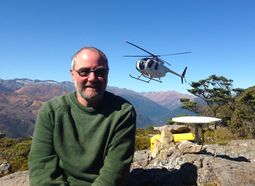BSc (Cant) MSurv (Otago) PhD (Newcastle, UK)  Email pdenys@surveying.otago.ac.nz
Email pdenys@surveying.otago.ac.nz
Tel +64 3 479 7596
Surveying building, 1st floor, Room 125
Profile
Paul joined the School in June 1995. He completed a MSurv degree at Otago University in 1987, after which he lectured for six months at the University of Cape Town. He then worked as a site engineer in London before carrying out a variety of traditional and GPS control surveys and engineering setting out surveys in the oil and exploration industry in Egypt.
In 1991 he undertook studies for a PhD at the University of Newcastle, England (completed 1995) in height determination using ground-based transponders in conjunction with the radar altimeter on the ERS-1 remote sensing satellite. During this time he was appointed as a Research Associate at the University where he was involved in processing of precise GPS networks for projects in Greece, Europe and Britain. He also worked for Racal Survey in the Middle East, Far East and Europe on GPS related projects specific to the off-shore oil and exploration industry.
Since joining Otago University, his primary research focus has involved projects on the deformation of the South Island, vertical uplift of the Southern Alps, the effect of and integration of deformation events (e.g. earthquakes) on geodetic infrastructure and decoupling vertical land movement at tide gauge stations.
Teaching
SURV202 Survey Mathematics (coordinator)
SURV301 Survey Methods (coordinator)
SURV451 Advanced Survey Methods (coordinator)
Research
Research Interests
- Precise GPS, geodesy, geodetic reference systems
- Global Navigation Satellite Systems
- Earth Deformation
- Sea level rise
- Vertical Land Motion
Current Projects
Southern Alps Geodetic Experiment (SAGENZ). Using CGPS to measure the rate and distribution of uplift of the Southern Alps.
Fiordland – Co-seismic and Post-seismic deformation. In July 2009, a Mw 7.8 earthquake caused horizontal displacements of up to 80cm in Fiordland, New Zealand.
Sea Level Rise. Monitoring the land movement at New Zealand's long record tide gauges.
Strain and Velocity Fields. Using GPS to measure the velocity field throughout the South Island (New Zealand). Hence determine the strain variability particularly in the Southern Alps and Central Otago.
Recent Publications
Page, C.J., P.H. Denys, and C. F. Pearson, (2018), A geodetic study of the Alpine Fault through South Westland: using campaign GPS data to model slip rates on the Alpine Fault, New Zealand Journal of Geology and Geophysics, doi: 10.1080/00288306.2018.1494006
Hamling, I.J., S. Hreinsdóttir, , ... P. Denys, ... and M. Stirling, (2017), Complex multifault rupture during the 2016 Mw 7.8 Kaikoura earthquake, New Zealand. Science, doi: 10.1126/science.aam7194
Beavan, J., L. M. Wallace, N. Palmer, P. Denys, S. Ellis, N. Fournier, S. Hreinsdottir, C. Pearson and M. Denham, (2016), New Zealand GPS velocity field: 1995–2013. New Zealand Journal of Geology and Geophysics 59(1): 5-14, doi: 10.1080/00288306.2015.1112817
Swales, A., P. Denys, V.I. Pickett, and C.E. Lovelock, (2016), Evaluating deep subsidence in a rapidly-accreting mangrove forest using GPS monitoring of surface elevation benchmarks and sedimentary records. Marine Geology, doi: 10.1016/j.margeo.2016.04.015
